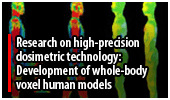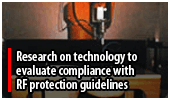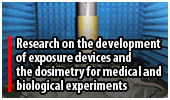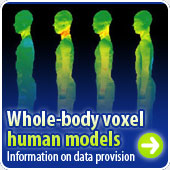The development of radio wave technologies in recent years has led to their increasing use in a growing range of applications. Ubiquitous network technologies are expected to become widespread, with people anticipated to wear various data processing terminals on various parts of their body for communicating wirelessly. There is, however, a growing concern about the possible health hazards of the radio waves that are emitted from these wireless communications devices.
Japan has established safety guidelines on radio waves to prevent their adverse effects on the human body, and to allay people's anxieties about them. These guidelines are based on the thermal effect that is created as the radio energy is absorbed by the human body. As one indicator for this, the amount of electromagnetic power absorbed per unit mass of a biological body, or Specific Absorption Rate (SAR), is used. Therefore, to study the safety of radio waves, it is necessary to precisely evaluate the SAR inside the body.
Absorption of radio waves strongly depends on the complex shape of the human body and the heterogeneous structure of the inner tissues. NICT has therefore developed whole-body voxel human models that simulate the complex structure of the human body and conducts numerical simulations to detailed dosimetry.
Development of whole-body voxel human models
To evaluate the safety of radio waves, it is necessary to make precise evaluations of SAR within the human body. SAR changes in a complex fashion, depending on the shape of the human body and the heterogeneous structure of the internal tissues. However, it is next to impossible to measure SAR directly within the human body, which was why assessments could thus far be made by using numerical human models or experimental phantoms with simple shapes and approximated structures.
Recent advances in medical diagnostic technologies have enabled the development of a precise whole-body voxel human model, based on accumulated anatomical image data such as MRI.
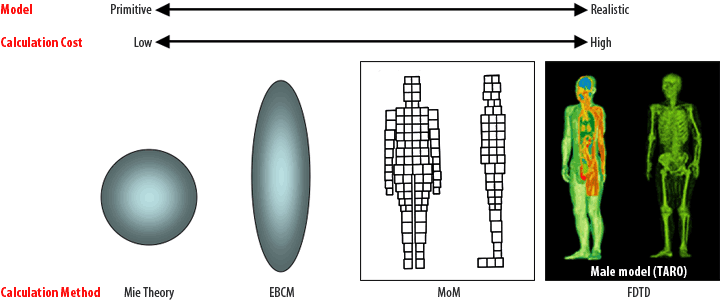
Transitions in Methods and Models for SAR Dosimetry
Development has been under way at NICT to create high-precision whole-body voxel human models that match the average body shapes of the Japanese. They represent a considerable step forward in this discipline, and are already in wide use in research in diverse fields both in Japan and other countries.
Numerical simulation using whole-body voxel human models
High-resolution whole-body voxel human models with anatomical structures, and models that simulate the body tissues in a simple fashion, are employed to estimate the behaviors of radio waves inside the human body and SAR. At NICT, our studies focus on the frequency bands that are mainly used in wireless communications, from several ten kHz to several hundred GHz. Particular emphasis is being placed on studies either in the VHF/UHF bands used at broadcasting stations and mobile phones, or in the intermediate frequency range used in RF-ID devices and IH cooking equipment.

